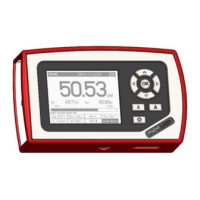5.6 Ambient and Stray Light
disturbances or by heating up the heat sink through long enough exposure of the
laser beam to the thermal disc.
To avoid disturbances it is recommended to shield the sensor as good as possible
from airflow and to zero it properly in the operating condition. That means for short
term measurements zero the cold sensor, for long term measurements zero the
sensor when it is in a state of thermal stability (e.g. after 10 minutes light exposure).
5.6 Ambient and Stray Light
Ambient or stray light can strongly affect the measurement accuracy in free-space
applications. A permanent background light level can be subtracted by conducting a
zero adjustment. More complicated is varying ambient light like daylight or turning
on/off room light. In such cases the only solution is a proper light shielding of the
sensor.
5.7 Back Reflection
Photodiodes, ND filters and even black coatings of thermal sensors show a certain
kind of back reflection of the incoming light. Back reflection for example to a diode or
HeNe laser can distort the power stability of the laser, therefore it is recommended to
slightly tilt the power meter sensor in the laser beam.
When back reflection must be avoided it is advised to use an integrating sphere
based S14xC series sensor where the incoming light gets nearly completely
absorbed in the sensor.
5.8 Beam Diameter vs. Active Sensor Area
Most sensors are not completely uniform in their response over the active area;
except are sensors that are using an integrating sphere as filter and diffuser.
To overcome uniformity issues the incident beam should have a diameter larger than
10% sensor area.
A second topic to follow are the maximum allowed power and energy densities of the
sensor. The maximum ratings are given in the sensor spec-sheet. The PM100D can
display the actual power or energy density for a known beam diameter. For high
power or high energy beams a good efficiency can be reached to chose a detector
that is about 20% - 30% larger than the beam diameter.
34

